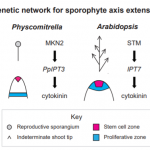Plant Science Research Weekly: August 16th
Review: Structural biology of cell surface receptor–ligand interactions
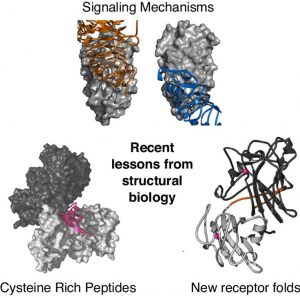 In recent months, a flurry of papers have come out that reveal new insights into the structural interactions of cell-surface receptors with each other and with their ligands. This timely review by Moussu and Santiago captures the highlights, in case you haven’t been following along. The review features the BRI1 brassinosteroid receptor and its toggling between binding partners to switch from inactive to active; receptor interactions with Cys-rich peptides including those involved in epidermal patterning and fertilization; and other, less well-characterized receptor-ligand interactions. These new insights reveal the complexity of the “sensosomes” that cell-surface receptors are integral to, and also affirms that “seeing is believing”. (Summary by Mary Williams) Curr. Opin. Plant Biol. 10.1016/j.pbi.2019.07.001
In recent months, a flurry of papers have come out that reveal new insights into the structural interactions of cell-surface receptors with each other and with their ligands. This timely review by Moussu and Santiago captures the highlights, in case you haven’t been following along. The review features the BRI1 brassinosteroid receptor and its toggling between binding partners to switch from inactive to active; receptor interactions with Cys-rich peptides including those involved in epidermal patterning and fertilization; and other, less well-characterized receptor-ligand interactions. These new insights reveal the complexity of the “sensosomes” that cell-surface receptors are integral to, and also affirms that “seeing is believing”. (Summary by Mary Williams) Curr. Opin. Plant Biol. 10.1016/j.pbi.2019.07.001
A KNOX-cytokinin regulatory module predates the origin of indeterminate vascular plants
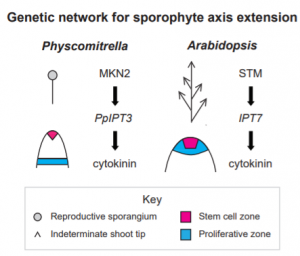 In vascular plants, new organs (e.g., leaves) are produced continuously from the shoot meristem, a process coined indeterminacy. The sister lineage of vascular plants, bryophytes, develop differently, ending with the formation of a determinate spore-bearing shoot (sporangium). The genetic underpinning of indeterminacy is well understood in vascular plants, but the mechanisms enabling the transition from determinacy to a vascular plant meristem still remain unclear. Here, Coudert et al. demonstrate that in the moss Physcomitrella patens, KNOX genes control stem development as well as cytokinin production, which is involved in regulating cell division. By characterizing KNOX protein functions in extant plants, this research informs our understanding of the ancestral function of these genes. This important functional unit predates the origin of vascular plants, and is derived from the common ancestor of vascular plants and bryophytes (Summary by Alex Bowles) Curr. Biol. 10.1016/j.cub.2019.06.083
In vascular plants, new organs (e.g., leaves) are produced continuously from the shoot meristem, a process coined indeterminacy. The sister lineage of vascular plants, bryophytes, develop differently, ending with the formation of a determinate spore-bearing shoot (sporangium). The genetic underpinning of indeterminacy is well understood in vascular plants, but the mechanisms enabling the transition from determinacy to a vascular plant meristem still remain unclear. Here, Coudert et al. demonstrate that in the moss Physcomitrella patens, KNOX genes control stem development as well as cytokinin production, which is involved in regulating cell division. By characterizing KNOX protein functions in extant plants, this research informs our understanding of the ancestral function of these genes. This important functional unit predates the origin of vascular plants, and is derived from the common ancestor of vascular plants and bryophytes (Summary by Alex Bowles) Curr. Biol. 10.1016/j.cub.2019.06.083
Cytoskeleton dynamics necessary for early events of lateral root initiation
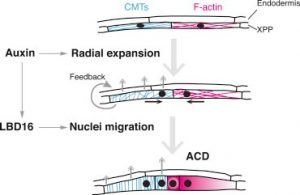 Symmetric cell division leads to proliferation, and asymmetric cell division establishes differential growth. Formation of lateral roots (LRs) depends on asymmetric division of initially symmetric founder cells. Barro et al. studied the mechanism of asymmetric radial expansion by analyzing cytoskeleton dynamics using mutants, pharmacological drugs, and tissue-specific perturbation. They expressed MAP4 (MICROTUBULE-ASSOCIATED PROTEIN4) specifically in founder cells using the GATA23 promoter and showed that asymmetric expansion of LR founder cells coincides with nuclear migration and microtubule re-orientation. Furthermore, microtubule destabilizing (oryzalin) and stabilizing (taxol) drugs revealed that microtubules are required for asymmetric radial expansion. Using tissue-specific genetic perturbation of auxin response, the authors found that auxin signaling plays critical roles for radial expansion and the reorganization of microtubules. They also showed that when actin networks are depolymerized, the nucleus doesn’t migrate in the founder cells so a symmetric division happens instead of asymmetric division. This article suggests that auxin signaling contributes to LR initiation through the co-ordination of F-actin dynamics for nuclear movement and microtubule re-orientation for asymmetric radial expansion in the founder cell. (Summary by Arif Asraf) Curr. Biol. 10.1016/j.cub.2019.06.039
Symmetric cell division leads to proliferation, and asymmetric cell division establishes differential growth. Formation of lateral roots (LRs) depends on asymmetric division of initially symmetric founder cells. Barro et al. studied the mechanism of asymmetric radial expansion by analyzing cytoskeleton dynamics using mutants, pharmacological drugs, and tissue-specific perturbation. They expressed MAP4 (MICROTUBULE-ASSOCIATED PROTEIN4) specifically in founder cells using the GATA23 promoter and showed that asymmetric expansion of LR founder cells coincides with nuclear migration and microtubule re-orientation. Furthermore, microtubule destabilizing (oryzalin) and stabilizing (taxol) drugs revealed that microtubules are required for asymmetric radial expansion. Using tissue-specific genetic perturbation of auxin response, the authors found that auxin signaling plays critical roles for radial expansion and the reorganization of microtubules. They also showed that when actin networks are depolymerized, the nucleus doesn’t migrate in the founder cells so a symmetric division happens instead of asymmetric division. This article suggests that auxin signaling contributes to LR initiation through the co-ordination of F-actin dynamics for nuclear movement and microtubule re-orientation for asymmetric radial expansion in the founder cell. (Summary by Arif Asraf) Curr. Biol. 10.1016/j.cub.2019.06.039
Manganese deficiency affects root endodermal suberization and ion homeostasis
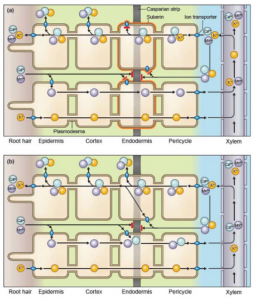 Manganese (Mn) is an essential plant nutrient necessary for multiple plant process such as photosynthesis. Mn deficiency has a significant impact on crop production particularly in cereals including barley (Hordeum vulgare L.). Chen et al. identified how Mn deficiency alters suberin deposition in the barley root endodermis. The suberin lamellae in the root endodermis provide the barrier for the movement of molecules, and the extent of suberization is altered by environmental conditions. Interestingly the authors observed an increased zone of unsuberized endodermal cells close to the root tip under mild Mn deficiency, and enhanced suberization under high Mn deficiency. Also, the movement of other ions like calcium, sodium, and potassium was altered under Mn deficiency. This change in suberization was reverted by supplementation of Mn to compensate for the deficiency. Thus the authors uncovered the mechanism by which plants cope under Mn deficiency by altering the uptake and movement of ions through altered suberization. (Summary by Suresh Damodaran) Plant Physiol. 10.1104/pp.19.00507
Manganese (Mn) is an essential plant nutrient necessary for multiple plant process such as photosynthesis. Mn deficiency has a significant impact on crop production particularly in cereals including barley (Hordeum vulgare L.). Chen et al. identified how Mn deficiency alters suberin deposition in the barley root endodermis. The suberin lamellae in the root endodermis provide the barrier for the movement of molecules, and the extent of suberization is altered by environmental conditions. Interestingly the authors observed an increased zone of unsuberized endodermal cells close to the root tip under mild Mn deficiency, and enhanced suberization under high Mn deficiency. Also, the movement of other ions like calcium, sodium, and potassium was altered under Mn deficiency. This change in suberization was reverted by supplementation of Mn to compensate for the deficiency. Thus the authors uncovered the mechanism by which plants cope under Mn deficiency by altering the uptake and movement of ions through altered suberization. (Summary by Suresh Damodaran) Plant Physiol. 10.1104/pp.19.00507
Transcriptomic and cell wall analysis of stinging nettle, an underutilized fibre crop
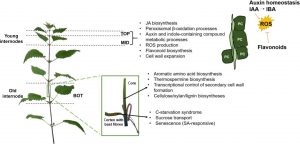 Plant fibres from crops such as flax and hemp have diverse uses from rope to clothing, and are increasingly being incorporated into eco-friendly biocomposite materials. These long, flexible, useful fibres, called “bast” fibres, are not derived from the xylem, but instead are derived from specialized cells located interior to the epidermis. Stinging nettle (Urtica dioica L.) is a traditional fibre crop that also has potential medicinal applications. Here, Xu, Backes et al. describe the development and formation of bast fibres in nettle, through transcriptomic and cell wall composition analyses. The authors studied “clone-13”, which has been selected for high fibre yield. They found a high level of soluble pectin polysaccharides where the fibres are elongating, and more Ca2+‐pectate gels in mature parts of the stem. They also carried out an analysis for gene ontology terms enriched in stem segments with developing or mature fibres, identifying sets of genes involved in signaling, differentiation, metabolic and cell wall formation. These studies will support the continuing development of nettle as a fibre crop. (Summary by Mary Williams) Plant Direct 10.1002/pld3.151
Plant fibres from crops such as flax and hemp have diverse uses from rope to clothing, and are increasingly being incorporated into eco-friendly biocomposite materials. These long, flexible, useful fibres, called “bast” fibres, are not derived from the xylem, but instead are derived from specialized cells located interior to the epidermis. Stinging nettle (Urtica dioica L.) is a traditional fibre crop that also has potential medicinal applications. Here, Xu, Backes et al. describe the development and formation of bast fibres in nettle, through transcriptomic and cell wall composition analyses. The authors studied “clone-13”, which has been selected for high fibre yield. They found a high level of soluble pectin polysaccharides where the fibres are elongating, and more Ca2+‐pectate gels in mature parts of the stem. They also carried out an analysis for gene ontology terms enriched in stem segments with developing or mature fibres, identifying sets of genes involved in signaling, differentiation, metabolic and cell wall formation. These studies will support the continuing development of nettle as a fibre crop. (Summary by Mary Williams) Plant Direct 10.1002/pld3.151
Single-cell genomics unveils an ectosymbiont cyanobacteria associated with a dinoflagellate host
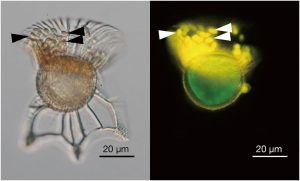 Cyanobacteria are important contributors to global carbon fixation. They can be free-living in many different environments, but also form close symbiotic associations with various eukaryotic organisms. Nakayama et al. have idea identified a new type of cyanobacteria that lives as an ectosymbiont in a specialized extracellular chamber of a marine dinoflagellate. This new cyanobacterium, which the authors refer to as OmCym (after the host, Ornithocercus magnificus), has a greatly reduced genome. Genes involved in membrane transport have been preferentially lost, perhaps due to the relatively stable environment provided by the host. Given that the cyanobacteria can be found in ingested food vacuoles, they may be considered to have been ‘domesticated’ by their hosts as a food source. The authors speculate that these widespread cyanobacteria may have been overlooked previously because they are hidden within their hosts, and raise the possibility that there may be other similarly ‘hidden’ species. (Summary by Mary Williams) Proc. Natl. Acad. Sci USA 10.1073/pnas.1902538116
Cyanobacteria are important contributors to global carbon fixation. They can be free-living in many different environments, but also form close symbiotic associations with various eukaryotic organisms. Nakayama et al. have idea identified a new type of cyanobacteria that lives as an ectosymbiont in a specialized extracellular chamber of a marine dinoflagellate. This new cyanobacterium, which the authors refer to as OmCym (after the host, Ornithocercus magnificus), has a greatly reduced genome. Genes involved in membrane transport have been preferentially lost, perhaps due to the relatively stable environment provided by the host. Given that the cyanobacteria can be found in ingested food vacuoles, they may be considered to have been ‘domesticated’ by their hosts as a food source. The authors speculate that these widespread cyanobacteria may have been overlooked previously because they are hidden within their hosts, and raise the possibility that there may be other similarly ‘hidden’ species. (Summary by Mary Williams) Proc. Natl. Acad. Sci USA 10.1073/pnas.1902538116



